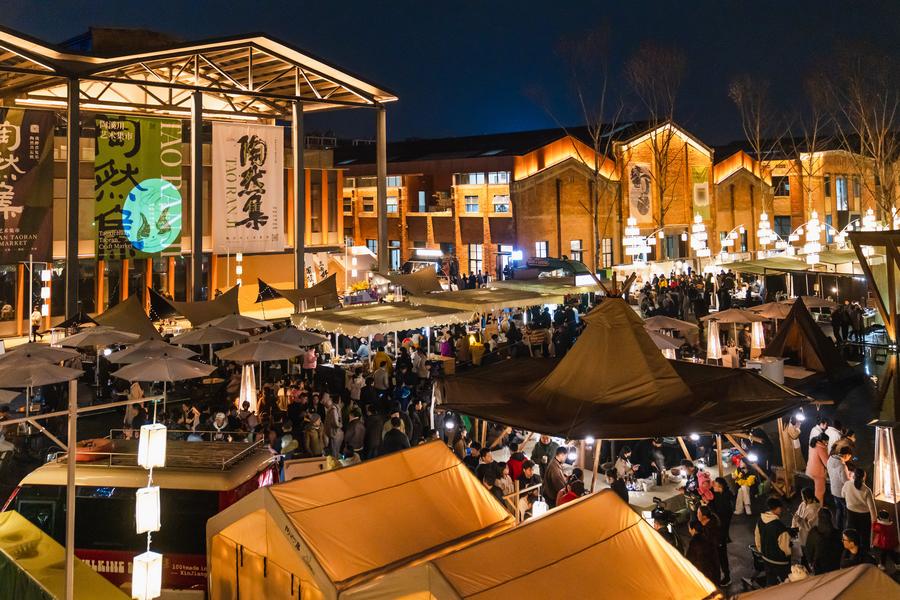* Over the past decade, more than 100,000 young people have chosen to build their future in Jingdezhen, China’s porcelain capital.
* The closure of major ceramic factories gave way to a new industrial structure. About 100,000 ceramic workers remained in the city, and the ceramic-making infrastructure was left intact, creating a fertile environment for newcomers to learn the craft with relatively low barriers to entry.
* In Jingdezhen, clay and glaze materials are just a phone call away, and even rare supplies can be found here. With low costs and a large market, no one feels alone on their entrepreneurial journey in this city.
NANCHANG, July 18 (Xinhua) — Sitting in his studio in east China’s porcelain capital of Jingdezhen, 33-year-old Zha Fuyuan carefully paints a cartoon-style version of Zhong Kui, the ghost catcher from Chinese folklore, onto a blank ceramic cup.
An avid painting enthusiast, Zha moved to Jingdezhen — a city in Jiangxi Province with over 2,000 years of ceramic-making history — ten years ago after graduating, to chase his artistic dream.
Though the early days were challenging, Zha’s China-chic designs have gained widespread popularity through livestreaming platforms, earning him an annual income of over 400,000 yuan (about 55,946 U.S. dollars).

“In Jingdezhen, if you’re willing to work hard, the city won’t let you down,” Zha said.
Zha is one of over 100,000 young people who have chosen to build their future in Jingdezhen over the past decade. Official data shows that more than half of the 60,000 so-called “Jingpiaos,” a local term for newcomers seeking opportunities here, were born after 1990.
YOUNG DREAMS FIRED IN KILN
What makes Jingdezhen so attractive to young creatives? The answer lies in a turning point around 2000, when the rise of the market economy led to the closure of 10 major ceramic factories here that once produced nearly half of China’s household ceramics.
The downturn gave way to a new industrial structure. About 100,000 ceramic workers remained in the city, and the ceramic-making infrastructure was left intact, creating a fertile environment for newcomers to learn the craft with relatively low barriers to entry.
In 2016, the city opened Taoxichuan Ceramic Art Avenue, aimed at preserving 22 historic factory buildings and more than 30 old kilns. The area also features galleries, workshops and exhibition halls, as well as pedestrian-only streets, making space for young artists to set up stalls.
Each month, 1,200 applicants with original, high-quality works are selected from over 4,000 to set up stalls in Taoxichuan. Among them, the top 300 are offered space in an entrepreneurial incubation base. Those who reach an annual turnover of over 300,000 yuan and establish their own studios can “graduate,” thereby making room for new creators.
Mou Weixing, a 26-year-old from southwestern Chongqing Municipality with a background in animation design, runs a stall once a week, with a monthly income of around 9,000 yuan.
“In Jingdezhen, clay and glaze materials are just a phone call away, and even rare supplies can be found here,” Mou said. “A kiln costs only about 5,000 yuan, and communal firing is just 50 yuan per session. With low costs and a large market, no one feels alone on their entrepreneurial journey in this city.”
To further support young artisans, four new low-rent youth apartment blocks are being built near Taoxichuan. Graduates are also eligible for interest-free loans, and a talent service bureau has been established to assist the city’s “Jingpiaos”.
MORE THAN JUST CERAMICS
In Jingdezhen, the Taoran Craft Market, a quarterly fair featuring handmade crafts, coffee and glassworks, draws more than 120,000 visitors each time it opens.
“The market is no longer limited to ceramics, but a platform for a broad range of artistic expressions,” said Hua Jing, 31, who innovatively launched the craft fair in 2022.

This growing diversity is reflected in the city’s expanding creative industries. There are now 11 distinct categories, including lacquerware, weaving and metal arts, with about 11,000 artisans actively engaged.
“Expanding creative industries have injected new vitality into the city, drawing a more diverse community of young people,” said Goh Zhenxi, 31, who came to Jingdezhen from Malaysia ten years ago to study ceramic-making and now works at Taoxichuan. “Their arrival is fueling the cross-disciplinary integration and innovation of ceramic art.”
As night falls, Taoxichuan transforms into a vibrant stage. Young trainees from the Phonbay Training Institute, based on the avenue, take the stage with livestreamed shows of music and dance.
“In this city, everyone pursues what they truly desire, and this is not limited to pottery. Each person can discover a lifestyle and approach to work that suits them,” said Liu Nan, head of Phonbay Training Institute.
(Reporting by Wang Yihan, Huang Haoran, Yuan Huijing; video reporter: Guo Jiewen, Yu Gang; video editors: Hong Ling, Li Qin, Yin Le, Wang Houyuan) ■

